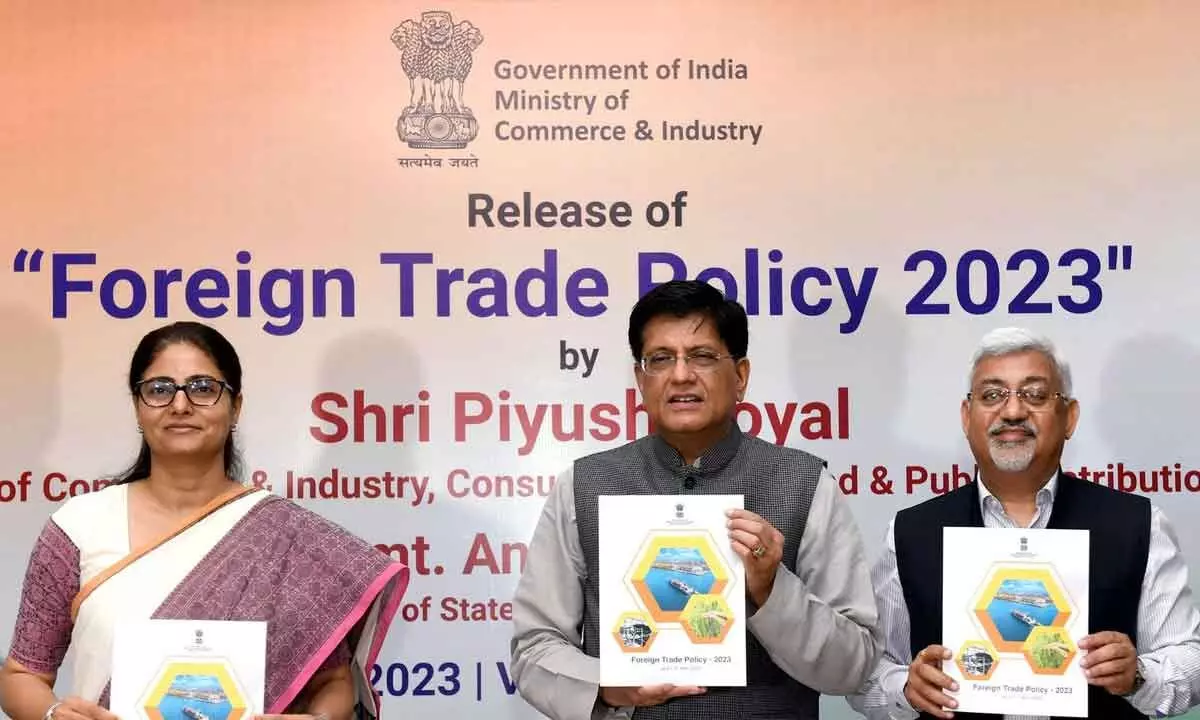India pursuing a rather ambitious exports goal
An annual average of over 14% for the next seven years needed to achieve the exports target of $two trillion by 2030
image for illustrative purpose

Union Minister for Commerce and Industry, Piyush Goyal, has announced Foreign Trade Policy (FTP) 2023, whereupon the plan is to target $2 trillion (Rs 164 lakh crore) in exports by 2030. India's overall exports have crossed over $765 billion (Rs 62.7 lakh crore) in FY23, the country would have to clock an average of over 14 per cent annually for the next seven years to reach that figure.
Experts say that the projections look optimistic as exports grew only by around 10 per cent in FY23. They point out that though robust exports were a key factor in India's post-Covid recovery—after dipping to $291.8 billion (Rs 24 lakh crore) in 2020-21, merchandise exports rose to a phenomenal $422 billion (Rs 34.7 lakh crore) due to pent up demand in 2021-22—that kind of growth was not sustainable in FY23.
Goyal believes that the new FTP can help India achieve its export goals. The policy is based on four pillars: incentive to remission, that is, taxes and levies borne on the exported products should either be exempted or remitted to exporters; export promotion through collaboration; ease of doing business, reduction in transaction cost and e-initiatives; developing districts as export hubs and streamlining SCOMET (special chemicals, organisms, materials, equipment and technologies) policy.
Simultaneously, the Centre can boost exports by forging trade partnerships with the UAE, Australia, the UK, Canada and Israel, and perhaps GCC (Gulf Cooperation Council). Towards this, India should also look at the US, which is one of the world’s biggest markets, as a potential partner.
However, India is beginning to feel the ripples of a major economic slowdown in the developed world. Global growth is expected to slow down to 2.2 per cent this year from an estimated 3.4 per cent, with the US economy contracting 0.1 per cent while the Eurozone will be flat, as the impact of continued monetary policy tightening across major economies becomes apparent.
The US Federal Reserve recently hiked interest rates further as a means to arrest inflation, putting pressure on its banking sector, following the collapse of Silicon Valley Bank and Signature Bank. Europe, too, is left shaken by the fall of Credit Suisse, its second largest bank, which was subsequently taken over by UBS, the country's largest bank.
India may feel the heat to some extent as labour-intensive sectors like textiles, footwear and leather depend on exports to these zones, making them particularly vulnerable, says a Crisil report. Already, commodity prices have softened, hitting exporters. Growth in exports is likely to remain flat even in 2023-24. Also, the competitive advantage India enjoys from the rupee's weakening may not hold either, as most currencies have been weakening against the dollar.
From being the tenth largest economy in FY 2014, India is likely to grow into the world’s third largest economy in FY 2028. The plus one strategy and ease of doing business along with enhanced competitive/innovation index ranking and infrastructure push will alter the business landscape.
For the last three years, the Indian economy has been the fastest growing economy at 8.7%, 6.8% and 6.1%, respectively. This year RBI forecasts growth at 6.4%. If the receding commodity prices stay at low levels, it will be a positive sign for growth of the economy.
Though India contributes 3.1% of GDP, our export contribution to the world has been a mere 1.6% and looking at the current opportunities, it has immense scope, potential and triggers to grow. By 2028, it is expected that India will reach one trillion of manufacturing exports.
At present, our exports are about 20 per cent of the GDP. Considering the size of the economy, the potential and the base of our manufacturing and service industry, it has the wherewithal to grow tremendously. On that count, India needs to have a seamless and high-quality supply chain and low-cost logistics to boost exports.
Challenges are still there and in 2023 we may see slower growth as the 2022 base is high. More than 45% of the manufacturing output is obtained from the MSME sector. Hence their connectivity to the global market is extremely important. Bonded warehouses were one such initiative by CBIC. New fields like space and exports can increase Indian share of the global exports pie by 2026. Estimates have suggested annual defence exports of Rs35,000 crore by the end of FY 2025.
The key reasons for good export performance are sharp recovery in key markets, increased consumer spending, accumulated savings and disposable income due to the announcement of fiscal stimulus by major economies, global commodity price rise, and an aggressive export push by the government.

